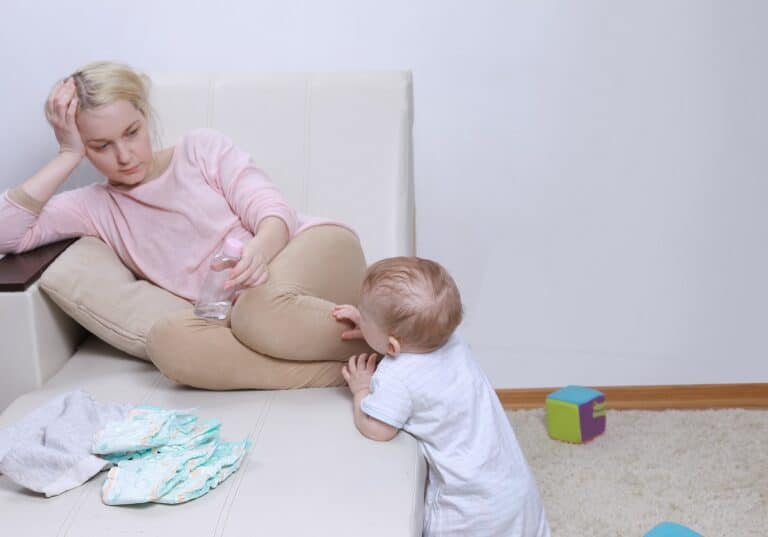We’ve all heard the term postpartum depression, but do we really know what it means? Simply put, it’s a type of depression that affects mothers after giving birth. But there’s more to this story than meets the eye.
In This Article
Defining Postpartum Depression (PPD)
Did you know that up to one in five women experience PPD? It’s more common than you might think. The symptoms can vary from person-to-person but often include feelings of sadness, anxiety and fatigue. Moms who have difficulty bonding with their babies or lose interest in things they once enjoyed may also be experiencing this condition.
Let’s break down those commonly experienced emotions a little further:
- Sadness: feeling blue and frequently crying for no apparent reason.
- Anxiety: worrying about small issues becoming big when fear creeps in.
- Fatigue: feeling constantly tired without even having done much.
So how do we recognize these symptoms and identify risk factors for PPD? Awareness is key! Knowing whether someone has a history of depression or anxiety before pregnancy can help predict potential struggles after childbirth. Other predisposing factors may include high levels of stress at home or work coupled with sleep disruption due to baby care duties leading up to exhaustion.
Recognizing The Symptoms Of PPD
Elevated moods come naturally after having given life and finally holding your child close in your arms – it feels amazing! However, and not as expected by most mothers, something far from anticipated may happen. Instead of joy, they experience lows beyond expectation causing confusion and leaving many questioning ‘why am I unhappy?’ if everything seems fine.
It’s worth noting that some moms avoid opening a brewing conversation regarding their mood changes out of fear of being judged, misunderstood by their partner, friends, and family. However vulnerability never hurts anyone, and oftentimes, seeking counsel helps heal sooner compared to bottling it all up!
Symptoms of PPD can vary, but some common ones to take note of include:
- Insomnia or excessive sleep
- Decrease in appetite or overeating
- Difficulty bonding with baby despite wanting to badly
- Overwhelming guilt coupled with shame and/or low self-esteem
Identifying Risk Factors for PPD
Unrecognized by most mom-to-be(s), significant events such as late-in-life birth, unwanted pregnancy, financial hardship and/or substance abuse might stir mood changes leading up to childbirth. A balanced lifestyle beforehand, ideally paired with friends and family ensuring a smooth transition period makes things significantly more manageable.
Recent research indicates that women who experience prenatal depression are at higher risk for developing postnatal symptoms; therefore seeking care early on during your pregnancy may provide protective factors making things smoother afterwards.
Other high-risk factors commonly seen include experiencing trauma around parental death loss not long ago, limited social connection during this important transitional phase preceding labor and delivery.

Role Of Hormone Imbalances In Postpartum Depression
Hormones are like little messengers throughout our body telling different parts what needs to be done. When level changes occur, especially after pregnancy where estrogen & progesterone levels soar way high, these hormones may sometimes tend towards dropping instead of increasing – which subsequently triggers mood swings, culminating in symptoms of clinical depression.
It’s important to mention that unusual hormonal shifts happen other times beyond birth including menstruation cycle and menopausal stages when similar fluctuation patterns may adversely affect mood.
Treatment Options For Postpartum Depression
Here are some treatment options commonly offered in dealing with postpartum depression:
Hormone replacement therapy: this approach attempts at restoring a delicate hormone balance with the help of a personalized hormone therapy program, generally obtained through your physician or from a hormonal wellness center. The significant advantage of hormone replacement therapy is it helps restore the most optimal hormonal environment conducive for healing.
Medication options such as antidepressants: proven helpful for clinical level symptoms under medical guidance, they are generally avoided if breastfeeding.
Psychological therapies (like cognitive-behavioral therapy and interpersonal therapy): they provide access to successful long-run resolutions (besides prescription HRT or medication), and also provide crucial coping skills useful against future potential depressive symptoms.
Lifestyle changes and self-care strategies can also make significant differences, and these include relaxation techniques, prenatal yoga classes, and participating in activities that lift mood levels.
Prevention And Management Of Postpartum Depression
Early interventions help prevent postpartum depression and it all starts during your preconception planning stages whereby you prepare early by building a strong social support network while limiting stressors beforehand. Special focus needs be given towards recovery periods, encouraging moms to maintain balanced lifestyles whilst prioritizing regular medical checkups to swiftly identify any early symptoms and take prompt action.
Understanding PPD And Hormone Imbalances Matters
In conclusion, recognition and early diagnosis are key to detecting and identifying PPD. Understanding how natural hormonal imbalances play into maternal mental health extremely is crucial. It’s also very important for new moms to receive all the help they need, as well as solid empathetic companionship during this often turbulent time. So do reach out for help, don’t suffer in silence – you are worth it!











